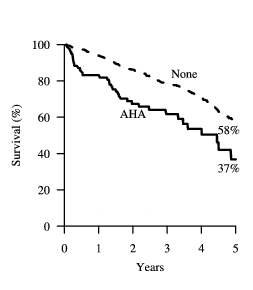 |
||||||||||
Date: February 9, 2025
by Chaya Venkat
Related Articles: AIHA;

Unless you have been diagnosed just recently, and have not yet become familiar with the lay of the land, you know that autoimmune complications such as AIHA (autoimmune hemolytic anemia; sometimes also abbreviated to AHA) can be scary and possibly life-threatening complications. Sometimes, AIHA occurs all by itself. But often, it is precipitated by the drugs chosen to treat the underlying CLL. The good news is that not all drugs are equal, some drugs and some combinations are safer to use in terms of lowering the risk of developing therapy-induced-AIHA.
Dr. Robin Coombs defined this test back in 1945 and it is sometimes called the “Coombs test” in his honor. As more and more physicians began using it, it became clear that CLL patients who test positive for this test are more likely to develop AIHA. Here is a link that tells you a lot more about the DAT or Coombs test, if you are interested: CMAJ Case Study.
For those of you who are unfamiliar with AIHA, I strongly recommend that you browse through our review article on the subject (AIHA). In a nutshell, in AIHA patients perfectly good red blood cells are attacked and destroyed by the patient’s own immune system. While we do not have all the answers yet, it is thought that the good B-cells in your body (not the CLL B-cells) are tricked into producing antibodies that tag red blood cells and mark them for destruction. In healthy people B-cells do not produce antibodies against the body’s own cells. Their job is to generate antibodies against invading pathogens such as disease causing bacteria. In CLL patients this important distinction between “self” and “non-self” breaks down. It is as if the wonky immune system becomes paranoid, seeing enemies even among friends and killing perfectly good cells in a mad frenzy. There are clues pointing to corruption of T-cells by the cancerous B-CLL cells, which in turn befuddle even the few good B-cells our guys have. Plummeting red blood cell counts and hemoglobin levels triggered by AIHA cause havoc with quality of life. Patients tell me bending down just to tie their shoe laces becomes a major task when they don’t have enough of the oxygen carrying red blood cells in their bodies. AIHA is shown to be more common in advanced CLL than in early stage CLL – makes sense to me, the increasing numbers of CLL cells can do more damage in getting the rest of the immune system out of whack.
There is a great deal of confusion about the “best” frontline therapy for CLL patients. Here are some pointers that can help.
The UK CLL4 trial is an extraordinarily important and well conducted trial. A large number of previously untreated CLL patients were randomized into three groups. The first group was treated with single agent chlorambucil (Chl); the second group got single agent fludarabine (F); the third group got a combination of fludarabine and cyclophosphamide (F+C). I know – conspicuous by its absence is any mention of Rituxan (R), the anti-CD20 monoclonal antibody that has taken the CLL arena by storm. Not to worry, a subsequent trial compared F+C versus F+C+R and I will be reviewing those results shortly. Rituxan is not always an option for CLL patients worldwide – the mouse juice costs a pretty penny and not everyone can afford it, insured or not. The three drugs used in this CLL4 trial (chlorambucil, fludarabine, cyclophosphamide) are all relatively cheap and off-patent, and therefore much more accessible to patients worldwide. It also helps that each of these drugs is available as an oral formulation. A pill to swallow can be a lot easier than a trip to the doctor’s office for an intravenous infusion.
Since too many oncologists still consider fludarabine as a single agent the de-facto “gold standard” for frontline therapy for CLL patients, you can see why the UK CLL4 trial is important. What is the best drug (or combination of drugs) to use right out of the gate? Does the choice of frontline therapy influence remission length, quality of remission – and most important to us chickens, overall survival? Is there reason to choose one drug or another on the basis of reducing the risk of autoimmune complications? How about quality of life? All of these are important considerations, and I plan to write a series of articles on these subjects in the next few weeks. But this article will focus on the subject of autoimmune disease, specifically AIHA. You will be right if you think I am a little “motivated” on the subject of AIHA. I lost a couple of good friends to this nasty CLL complication.
Below is the abstract of a recent paper in Blood that examined the AIHA implications brought into focus by the UK CLL4 trial, followed by my own cheat sheet version of the highlights. If you have AIHA or you have tested positive for the Direct Coombs test (DAT), you may want to read the full text of the article. If you wish, write to us and we will help you locate a full text copy of it.
Blood. 2025 Nov 30
The prognostic significance of a positive direct antiglobulin test in chronic lymphocytic leukemia - a beneficial effect of the combination of fludarabine and cyclophosphamide on the incidence of hemolytic anemia.
Dearden C, Wade R, Else M, Richards S, Milligan D, Hamblin T, Catovsky D.
Section of Haemato-Oncology, Royal Marsden NHS Foundation Trust and Institute of Cancer Research, Sutton, United Kingdom.
Autoimmune hemolytic anemia (AHA) is a common complication in chronic lymphocytic leukemia (CLL). The UK LRF CLL4 trial is the largest prospective trial in CLL to examine the prognostic impact of both a positive direct antiglobulin test (DAT) and AHA. 777 patients were randomized to receive chlorambucil or fludarabine, alone or with cyclophosphamide (FC). The incidence pre-treatment of a positive DAT was 14%. 10% developed AHA. The DAT correctly predicted the development, or not, of AHA after therapy in 83% of cases, however only 28% of DAT positive patients developed AHA. Of 299 patients tested both pre- and post-treatment, those treated with single-agent fludarabine were most likely to remain DAT positive and to change from negative to positive. Patients treated with chlorambucil or fludarabine were more than twice as likely to develop AHA as those receiving FC. In a multivariate analysis, stage C disease and high beta-2 microglobulin were independent predictors of a positive DAT result. AHA, or a positive DAT, with or without AHA, independently predicted for reduced overall survival (OS). Four deaths, all on fludarabine monotherapy, were attributed to AHA. In conclusion, DAT status at the time of initiation of therapy provides a new prognostic indicator, although FC may protect against AHA.
This trial was registered at http://isrctn.org as #58585610.
PMID: 18055869
____________
 As you would expect, patients with late stage CLL (10.5% Binet stage C patients versus 2.9% Stage A patients had AIHA) and high B2M (beta 2-microglobulin) levels are more likely to develop AIHA.
As you would expect, patients with late stage CLL (10.5% Binet stage C patients versus 2.9% Stage A patients had AIHA) and high B2M (beta 2-microglobulin) levels are more likely to develop AIHA.I am sure there are some patients out there reading this review who have already been there, done that: patients who were treated with the supposed gold-standard fludarabine and may have developed AIHA as a consequence. I can understand your bitterness, your sense of having walked into the proverbial brick wall without knowing it was even there. There is no way to un-do the past, no way to un-ring the bell that has been rung. The best you can do is to put it behind you as so much murky water under the bridge and go forward with the determination not to be blind-sided again, if you have anything to do with it.
This review is for the benefit of those that have not yet made these therapy decisions. Given the importance of the UK CLL4 study, the wide publicity it has received at industry conferences and the prestigious professional journals that have published the results, one would think each and every local oncologist is now intimately familiar with the findings. One would think so, but I would not be willing to bet the farm on that assumption. I still hear from dozens of patients who are recommended fludarabine monotherapy almost as soon as they are diagnosed, without any prognostic testing, no DAT testing and often with no prophylaxis to protect against infections.
It seems the trickle down of hard won knowledge from the experts to the local providers of healthcare takes a good long while. It will eventually get there, but in the meantime I think it would be a shame if new members of our patient community have to pay the price for the slow pace. No one is a better advocate for your health than you. No one has more skin in this game than you. If you cannot be bothered to learn and watch out for what may come to bite you down the road, who will? Stay tuned, stay informed, and stay proactive. The life you save will be your own.
 Enter Keywords: |
———
Disclaimer: The content of this website is intended for information only and is NOT meant to be medical advice. Please be sure to consult and follow the advice of your doctors on all medical matters.
Copyright Notice:
Copyright © 2025-2007 CLL Topics, Inc. All Rights Reserved.
All materials contained on this site are protected by United States copyright law and may not be reproduced, distributed, transmitted, displayed, published or broadcast without the prior written permission of CLL Topics, Inc. You may not alter or remove any trademark, copyright or other notice from copies of the content.
However, you may download and print material from CLLTopics.org exclusively for your personal, noncommercial use.
———
